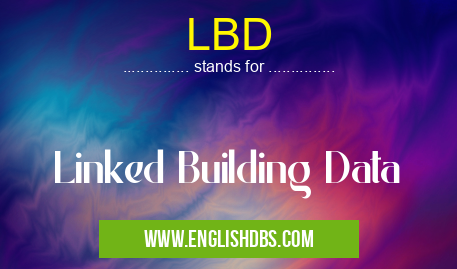What does LBD mean in UNCLASSIFIED
LBD is an abbreviation that stands for Linked Building Data. It is a data model that extends the Building Information Model (BIM) with semantic web technologies. LBD aims to make building data more accessible, interoperable, and reusable across different applications and stakeholders.

LBD meaning in Unclassified in Miscellaneous
LBD mostly used in an acronym Unclassified in Category Miscellaneous that means Linked Building Data
Shorthand: LBD,
Full Form: Linked Building Data
For more information of "Linked Building Data", see the section below.
What is LBD?
LBD is based on the Resource Description Framework (RDF), a W3C standard for representing data in a structured way. RDF allows data to be expressed in the form of triples, consisting of a subject, predicate, and object. In LBD, building data is represented as a collection of RDF triples, which can be linked to other data sources using Uniform Resource Identifiers (URIs).
Benefits of LBD
- Improved data interoperability: LBD enables different applications and stakeholders to exchange and understand building data more easily, regardless of their software or data formats.
- Enhanced data accessibility: LBD makes building data more accessible to a wider range of users, including architects, engineers, contractors, and building owners.
- Increased data reusability: LBD allows data to be reused for multiple purposes, such as facility management, energy analysis, and sustainability assessments.
- Support for collaboration: LBD facilitates collaboration among different stakeholders involved in the building lifecycle, by providing a common data model and ontology.
Essential Questions and Answers on Linked Building Data in "MISCELLANEOUS»UNFILED"
What is Linked Building Data (LBD)?
Linked Building Data (LBD) is a standardized way to represent and exchange building-related information using semantic web technologies. It provides a common framework for describing building properties, relationships, and performance data, enabling the integration and analysis of information from diverse sources.
What are the benefits of using LBD?
LBD offers several benefits, including:
- Enhanced data interoperability: Facilitates data exchange and integration between different building-related systems and applications.
- Improved data quality: Enforces data validation and integrity rules, ensuring the accuracy and consistency of information.
- Increased data transparency: Provides a structured and standardized format for representing building data, making it more accessible and understandable.
- Advanced analytics and visualization: Supports sophisticated data analysis and visualization capabilities, enabling users to uncover insights and make informed decisions about building performance.
How is LBD used in practice?
LBD has various applications in the building industry, such as:
- Facility management: Managing building information, tracking maintenance schedules, and optimizing energy consumption.
- Building design and construction: Sharing design data, collaborating on project plans, and ensuring regulatory compliance.
- Energy efficiency and sustainability: Monitoring building performance, identifying energy-saving opportunities, and achieving sustainability goals.
What are the key features of LBD?
Key features of LBD include:
- Ontology-based data model: Uses well-defined ontologies to represent building-related concepts and relationships.
- Standardized vocabularies: Employs standardized vocabularies to ensure consistent terminology and data interpretation.
- RDF representation: Leverages Resource Description Framework (RDF) as the data exchange format, enabling machine-readable and interoperable data.
- Linked data principles: Adheres to linked data principles, allowing data to be connected and shared across different datasets.
How can I get started with LBD?
To get started with LBD, consider the following steps:
- Familiarize yourself with the LBD ontology and data model.
- Use LBD-compliant tools for data management and exchange.
- Collaborate with other stakeholders to adopt LBD in your organization or industry.
- Explore existing LBD datasets and applications to gain practical insights.
Final Words: LBD is a powerful data model that has the potential to revolutionize the way building data is managed and used. By leveraging semantic web technologies, LBD enables better data interoperability, accessibility, reusability, and collaboration. As the adoption of LBD grows, it is expected to play a significant role in improving the efficiency and effectiveness of building design, construction, and operation.
